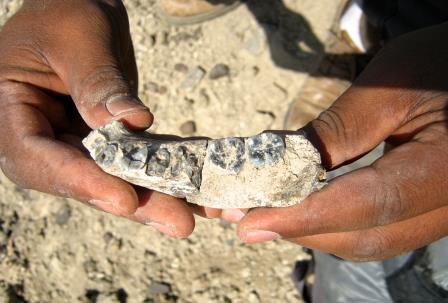In the Afar region of Ethiopia, paleoanthropologists unearthed a 2.8 million-year-old jawbone (mandible) that was provisionally assigned to the genus Homo [the genus of human beings, including modern humans (Homo sapiens) and other extinct species]. This fossil discovery, announced in the journal Science in 2015, is extremely important because it fills in a notable gap in the ancient timeline of human evolutionary history. See also: Anthropology; Fossil; Physical anthropology

Previously, the oldest known fossil of a Homo species had been dated to approximately 2.3 million years ago (MYA). The next oldest group of fossils from ancient human ancestors has been dated to approximately 3 MYA or older, and its members are considered to belong to the genus Australopithecus, including, for example, the source of the famous Lucy fossil (Australopithecus afarensis). Thus, a gap of about 700,000 years yawned between the Australopithecus and Homo fossil groups, and it had left investigators unable to accurately decipher the exact progression of human evolution during this crucial period. The Afar mandible discovery, however, pushed back the age of the Homo genus by 500,000 years, thereby narrowing the gap and providing paleoanthropologists with a clearer view of how humans evolved. See also: Australopith; Australopithecus sediba; Dating methods; Earliest hominins; Fossil hominids from Dmanisi; Fossil humans; Human origins; Infant Australopithecus from Dikika
The fossil itself is a small, lower-left jawbone of a hominid. It is remarkably well preserved, and it displays features that are more in line with other Homo specimens than with Australopithecus ones. In particular, the new discovery contains five teeth. These teeth are slim, symmetrically shaped (especially the molars), and have a distinctive cusp pattern, making them similar to other teeth specimens belonging to the Homo genus. In addition, the shape of the bony body of the mandible is a trait shared with other Homo species. With this anatomical evidence, the dating of the jawbone to 2.8 MYA has led investigators to view it as a probable link between Australopithecus afarensis and early Homo species (including possibly Homo habilis and Homo erectus, which date back to 1.9–1.8 MYA). See also: Dental anthropology; Homo erectus; Tooth
Although the investigative team declared the jawbone to be a specimen from the Homo genus and speculated that human species must have evolved at least a half-million years earlier than had been estimated, other researchers have been more cautious and are not satisfied enough by this single discovery to reconfigure the hominid family tree. Thus, the assignment of the jawbone to the Homo genus requires further confirmation, and additional fossil evidence dating to approximately 2.8 MYA must be uncovered before any conclusions can be regarded definitive. See also: Animal evolution; Phylogeny; Taphonomy





